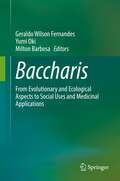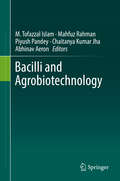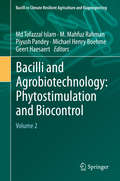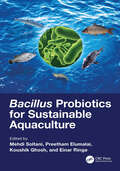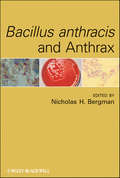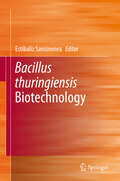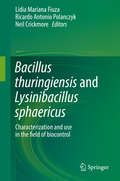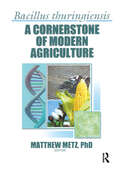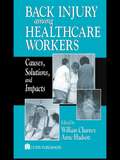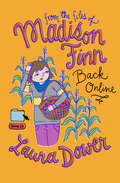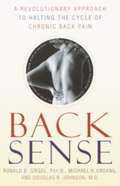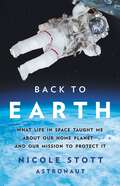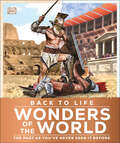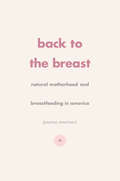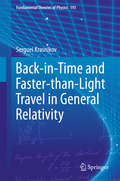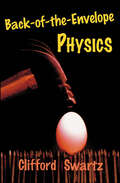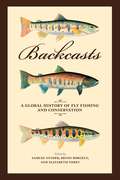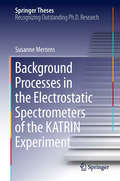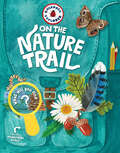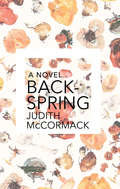- Table View
- List View
Baccharis: From Evolutionary and Ecological Aspects to Social Uses and Medicinal Applications
by Geraldo Wilson Fernandes Yumi Oki Milton BarbosaThis book has a broad scope and provides a comprehensive overview of the most up-to-date knowledge of the plant genus Baccharis. The book is organized into four major topics encompassing the evolution, ecology, chemistry, as well as environmental and medical applications of the genus. This publication is a major reference for an audience of practising researchers, academics, PhD students, and other scientists in a wide-ranging collection of fields, from Sociology to Medicine to bioeconomy.
Bacilli and Agrobiotechnology (Bacilli in Climate Resilient Agriculture and Bioprospecting)
by Abhinav Aeron M. Tofazzal Islam Mahfuz Rahman Piyush Pandey Chaitanya Kumar JhaThis volume of comprehensive reviews updates our knowledge of research and commercialization of Bacillus-based products in agriculture and the environmental sector. The last couple of decades have witnessed tremendous growth of research on Bacillus species. Many of these species can produce industrial enzymes, and can act simultaneously as biofertilizers and as biopesticides inhibiting important phytopathogens. This "biocontrol" activity is now elucidated by a number of genomic and metabolomic studies. Bacillus formulations are being patented and commercialized on a regular basis. Understanding the biology, ecology and mechanism of action of these bacteria will play a role in the promotion of Bacillus-based products to support green technology in agriculture and agro-based industries.
Bacilli and Agrobiotechnology: Volume 2 (Bacilli in Climate Resilient Agriculture and Bioprospecting)
by Piyush Pandey Md Tofazzal Islam M. Mahfuz Rahman Michael Henry Boehme Geert HaesaertThe Gram-positive and spore-forming Bacilli are the most dominant group of bacteria that exist in various ecological niches on the earth. They represent one of the most important unmapped pools of biodiversity with immense potential of applications in agriculture, environment, and industry. As these bacteria are highly tolerant to stressful environment and enhance plant tolerance to harsh environment such as salinity, drought, and heavy metal toxicity, plant-associated Bacilli have high potential for promoting sustainable crop production. Many species of Bacilli are being commercially used as phytostimulator and biofertilizer. Some of them are applied as biopesticide for protecting crop plants from phytopathogens and insect pests. The Bacillus-based products are becoming popular in ecologically sound and climate resilient agricultural production system. In fact, Bacillus and allied species based formulations are already dominating the biopesticides market, although, to compete with other formulations and chemical alternatives, the biology of Bacillus had to be understood from perspective of such applications. Our understanding of the biology and molecular-basis of the beneficial effects of plant-associated Bacilli has greatly been progressed in recent years through genomics, metagenomics, post-genomics and metabolomics studies. The volume two of the series Bacilli and Agrobiotechnology comprehensively reviews and updates current knowledge of Bacilli as phytostimulant and biological control of plant pests. Better understanding the biology, ecology and mechanism of action of the beneficial strains of Bacilli will play a role in the development of products to support green biotechnology in agriculture and industries.
Bacilli in Agrobiotechnology: Plant Stress Tolerance, Bioremediation, and Bioprospecting (Bacilli in Climate Resilient Agriculture and Bioprospecting)
by M. Tofazzal Islam Mahfuz Rahman Piyush PandeyThe third volume of the series ‘Bacilli and Agrobiotechnology’ is comprised of 25 chapters that bring a unique perspective to the readers about Bacillus-mediated biotic and abiotic plant stress tolerance, bioremediation and bioprospecting. These chapters are prepared by the leading scientists of global repute. The negative impacts of agrochemicals such as chemical fertilizers and pesticides on human health and environment are paramount. Bacillus and allied genera of beneficial plant-associated microbes are presenting beacon of hope to the farmers, plant scientists and stewards of environment. Several chapters of this volume focus on the induction of various signaling pathways in plants by Bacillus spp. to alleviate biotic and abiotic stresses impacted by global climate change Agricultural lands contaminated with heavy metals affect the ecological food chain starting from crop cultivation. How the toxic effects of trace metals originating from industrial effluents and agrochemicals can be remediated? This book addresses how to overcome these issues by applying elite strains of Bacillus. Bioprospecting is a systematic and organized search for conversion of bioresources to industrially important products by utilizing microbe-derived metabolites. This volume is enriched by including the bioprospecting aspects mediated by Bacillus spp. with novel insights.
Bacillus Probiotics for Sustainable Aquaculture
by Koushik Ghosh Preetham Elumalai Mehdi Soltani Einar RingøThis book provides a comprehensive examination of the role of Bacillus bacteria in aquaculture, particularly focusing on finfish and shellfish. It begins with foundational chapters on the anatomy and physiology of these aquatic species, their immune systems, and the biology of Bacillus bacteria. The book discusses the specific interactions between Bacillus and the gastrointestinal tracts of fish and shellfish, examining the production and effects of Bacillus-derived exoenzymes and bacteriocins and their role in enhancing aquatic animal health and water quality. Additionally, the book covers the role of Bacillus in bioremediation, particularly in improving water quality, which is a significant concern in aquaculture. The latter sections delve into the application of Bacillus as probiotics and paraprobiotics in fish and shellfish culture, their integration in feed biotechnology, and a critical evaluation of their safety. The book concludes with a critical discussion on the safety and regulatory aspects of using Bacillus in aquaculture.This book is intended for professionals and practitioners in the aquaculture industry and researchers, academicians, and students in the fields of microbiology, marine biology, aquaculture, and veterinary medicine.
Bacillus anthracis and Anthrax
by Nicholas H. BergmanThe study of Bacillus Anthracis remains at the forefront of microbiology research because of its potential use as a bioterror agent and its role in shaping our understanding of bacterial pathogenesis and innate immunity. Bacillus Anthracis and Anthrax provides a comprehensive guide to all aspects of the organism, ranging from basic biology to public health issues associated with anthrax. This book will be a premier reference for B. Anthracis and anthrax to microbiologists, medical and public health professionals, bioterror research and preparedness, immunologists, and physiologists.
Bacillus thuringiensis Biotechnology
by Estibaliz SansineneaBacillus thuringiensis (Bt) has been used as a biopesticide in agriculture, forestry and mosquito control because of its advantages of specific toxicity against target insects, lack of polluting residues and safety to non-target organisms. The insecticidal properties of this bacterium are due to insecticidal proteins produced during sporulation. Despite these ecological benefits, the use of Bt biopesticides has lagged behind the synthetic chemicals. Genetic improvement of Bt natural strains, in particular Bt recombination, offers a promising means of improving efficacy and cost-effectiveness of Bt-based bioinsecticide products to develop new biotechnological applications. On the other hand, the different Bacillus species have important biotechnological applications; one of them is carried out by producing secondary metabolites, which are the study object of natural product chemistry. The amazing structural variability of these compounds has attracted the curiosity of chemists and the biological activities possessed by natural products have inspired the pharmaceutical industry to search for lead structures in microbial extracts. Screening of microbial extracts reveals the large structural diversity of natural compounds with broad biological activities, such as antimicrobial, antiviral, immunosuppressive, and antitumor activities that enable the bacterium to survive in its natural environment. These findings widen the target range of Bacillus spp., in special B. thuringiensis, besides insecticidal activity and help people to better understand its role in soil ecosystem.
Bacillus thuringiensis and Lysinibacillus sphaericus: Characterization and use in the field of biocontrol
by Lidia Mariana Fiuza Ricardo Antonio Polanczyk Neil CrickmoreThis volume presents a comprehensive perspective of the biopesticides Bacillus thuringiensis and Lysinibacillus sphaericus, from their basic biology to agriculture, forestry and public-health applications. It covers their ecology, virulence factors, and genetic characterization. The topics related to agriculture and forestry include mode of action, receptors of insect pests, and heterologous expression of toxins in insect cells and plants. Public-health researchers will find information on vector control programs with an emphasis on the Neotropical region. The book also discusses new products and the global market.
Bacillus thuringiensis: A Cornerstone of Modern Agriculture
by Matthew MetzMake the right decisions when it comes to pest control in agriculture!Bacillus thuringiensis: A Cornerstone of Modern Agriculture explores the impact that one of the most prominent biologically based pesticides has had on pest control technologyand the issues that surround its use. The book examines the development, use, and management of technologies derived from Bacillus thuringiensis (Bt), addressing the health, economic, environmental, and social concerns generated by the deployment of genetically engineered crops. Authors representing a diverse cross section of the international scientific community contribute review articles and research findings that address the use of Bt in microbial formulations and transgenic crops, technological advances in the genetic engineering of plants, advances in methodologies, and improved agricultural practices and productivity through the use of Bt cotton.Bacillus thuringiensis: A Cornerstone of Modern Agriculture examines the vital issues surrounding this Gram-positive bacterium. Contributors from academia, government, and industry address the safety of Bt for human consumption, its effects on non-target organisms, the role of microbial Bt products in crop production in the United States, and the utility and management of transgenic plants. The book also explores: engineering Bt transgenic rice for insect pest protection the Bt potato in developing countries Bt expression in sugarcane and cauliflower a comparative analysis of Bt cotton in Argentina the ecological impact, gene expression, and current resistance management requirements of Bt cotton in the United States and much more! Bacillus thuringiensis: A Cornerstone of Modern Agriculture is an essential resource for advanced students and technical specialists working in agriculture, biotechnology, entomology, pest management, and crop sciences. Stakeholders will also find it invaluable in regulatory decision making about genetically engineered crops, pesticide use, and crop protection.
Back Injury Among Healthcare Workers: Causes, Solutions, and Impacts
by William Charney Anne HudsonThe U.S. Bureau of Labor Statistics recently calculated nearly 60,000 musculoskeletal injuries to healthcare workers resulting from heavy lifting during attempts to move patients. Often the nurses, aides, orderlies, and attendants who suffered permanent injuries were forced out of the profession, straining an already inadequate pool of workers and
Back Online (From the Files of Madison Finn #23)
by Laura DowerMadison Finn is back online, and she's spilling all the details on her new friend, old flame, and very unexpected crush Madison, Aimee, Fiona, and the gang are ready for a new school year, but Madison knows that nothing is ever what you expect--especially when it comes to matters of the heart. Regardless of how prepared she is, the eighth grade is going to bring a bunch of awkward new experiences and some major surprises, including a new love interest--and a very confusing love triangle! Perfect for fans of the Dork Diaries, Back Online is the newest novel in the hugely popular From the Files of Madison Finn series.
Back Sense: A Revolutionary Approach to Ending the Cycle of Back Pain
by Ronald D. Siegel Michael H. Urdang Douglas R. JohnsonOn occasion nearly everyone experiences short-term back pain from sore or strained muscles. But for many who come to treat their back gingerly because they fear further "injury," a cycle of worry and inactivity results; this aggravates existing muscle tightness and leads them to think of themselves as having a "bad back." Even worse is the understandable but usually counterproductive assumption that back pain is caused by "abnormalities"-bulging disks, a damaged spine, and so on. However, these abnormalities are frequently found in those who have absolutely no pain whatsoever. In reality, most backs are strong and resilient, built to support our bodies for a lifetime; truly "bad backs" are rare. Drawing on their work with patients and studies from major scientific journals and corporations, the authors of Back Sense-all three are former chronic back pain sufferers themselves-developed a revolutionary self-treatment approach targeting the true causes of chronic back pain. It is based on conclusive evidence proving that stress and inactivity are usually the prime offenders, and it allows patients to avoid the restrictions and expense of most other treatments. After showing readers how to rule out the possibility that a rare medical condition is the source of their problem, Back Sense clearly and convincingly explains the actual factors behind chronic back pain and systematically leads readers toward recapturing a life free of back pain.
Back from the Brink: Saving Animals from Extinction
by Nancy CastaldoThe acclaimed author of Sniffer Dogs details the successful efforts of scientists to bring threatened animals back from the brink of extinction, perfect for animal lovers and reluctant nonfiction readers. With full-color photography.How could capturing the last wild California condors help save them? Why are some states planning to cull populations of the gray wolf, despite this species only recently making it off the endangered list? How did a decision made during the Civil War to use alligator skin for cheap boots nearly drive the animal to extinction?Back from the Brink answers these questions and more as it delves into the threats to seven species, and the scientific and political efforts to coax them back from the brink of extinction. This rich, informational look at the problem of extinction has a hopeful tone: all of these animals' numbers are now on the rise.
Back to Earth: What Life in Space Taught Me About Our Home Planet—And Our Mission to Protect It
by Nicole StottInspired by insights gained in spaceflight, a NASA astronaut offers key lessons to empower Earthbound readers to fight climate change. <p><p>When Nicole Stott first saw Earth from space, she realized how interconnected we are and knew she had to help protect our planetary home. <p><p>In Back to Earth, Stott imparts essential lessons in problem-solving, survival, and crisis response that each of us can practice to make change. She knows we can overcome differences to address global issues, because she saw this every day on the International Space Station. Stott shares stories from her spaceflight and insights from scientists, activists, and changemakers working to solve our greatest environmental challenges. She learns about the complexities of Earth’s biodiversity from NASA engineers working to enable life in space and from scientists protecting life on Earth for future generations. <p><p>Ultimately, Stott reveals how we each have the power to respect our planetary home and one another by living our lives like crewmates, not passengers, on an inspiring shared mission
Back to Life Wonders of the World (DK Back to Life History)
by DKFrom sunset at Stonehenge to the steps of the Forbidden City, see the wonders of the world and the people who built and used them brought back to life in stunning detail.Discover humanity's greatest monuments restored to their former glory in this guide to the wonders of the world. Incredible History: Wonders of the World turns back time to reveal realistic reconstructions of the most incredible monuments humankind has ever constructed.Imagine if you could travel back in time and visit the wonders of the world. Where would you go first? You&’ll feel the roar of the crowd in the Roman Colosseum, observe an eclipse at Chichen Itza and stride along the walls of Great Zimbabwe. Children aged 9+ will learn when and how it was constructed, and what it teaches us about how the people who lived at the site might have spent their days. Each story begins by showing you the wonder as it is today and you can marvel at the location recreated in jaw-dropping 3D detail.This fascinating guide to the wonders of the world contains: - Information that goes beyond the curriculum to give a truly international view of the past, from the Palace of Versailles in France to the largest Buddhist temple in the world: Borobudur, Indonesia.- Pages packed with fascinating facts, data, and detail. - The wonders of the world are restored to their former glory with 3D computer artworks, going into incredible detail and depth.- Story boxes that put the discovery in context and go behind the scenes showing how archaeologists unearth the past.With each page packed with fantastic facts and extraordinary pictures, Incredible History: Wonders of the World brings together the best bits of history and archaeology to recreate our wondrous past. Combining archaeological evidence and computer technology, the book brings the people and places of the past back to life before your very eyes.
Back to the Breast
by Jessica MartucciAfter decades of decline during the twentieth century, breastfeeding rates began to rise again in the 1970s, a rebound that has continued to the present. While it would be easy to see this reemergence as simply part of the naturalism movement of the '70s, Jessica Martucci reveals here that the true story is more complicated. Despite the widespread acceptance and even advocacy of formula feeding by many in the medical establishment throughout the 1940s, '50s, and '60s, a small but vocal minority of mothers, drawing upon emerging scientific and cultural ideas about maternal instinct, infant development, and connections between the body and mind, pushed back against both hospital policies and cultural norms by breastfeeding their children. As Martucci shows, their choices helped ideologically root a "back to the breast" movement within segments of the middle-class, college-educated population as early as the 1950s. That movement--in which the personal and political were inextricably linked--effectively challenged midcentury norms of sexuality, gender, and consumption, and articulated early environmental concerns about chemical and nuclear contamination of foods, bodies, and breast milk. In its groundbreaking chronicle of the breastfeeding movement, Back to the Breast provides a welcome and vital account of what it has meant, and what it means today, to breastfeed in modern America.
Back to the Moon: The Next Giant Leap for Humankind
by Joseph SilkA scientist’s inspiring vision of our return to the Moon as humanity’s next thrilling step in space explorationJust over half a century since Neil Armstrong first stepped foot on the lunar surface, a new space race to the Moon is well underway and rapidly gaining momentum. Laying out a vision for the next fifty years, Back to the Moon is astrophysicist Joseph Silk’s persuasive and impassioned case for putting scientific discovery at the forefront of lunar exploration.The Moon offers opportunities beyond our wildest imaginings, and plans to return are rapidly gaining momentum around the world. NASA aims to build a habitable orbiting space station to coordinate lunar development and exploration, while European and Chinese space agencies are planning lunar villages and the mining of precious resources dwindling here on Earth. Powerful international and commercial interests are driving the race to revisit the Moon, but lunar infrastructures could also open breathtaking vistas onto the cosmos. Silk describes how the colonization of the Moon could usher in a thrilling new age of scientific exploration, and lays out what the next fifty years of lunar science might look like. With lunar telescopes of unprecedented size situated in permanently dark polar craters and on the far side of the Moon, we could finally be poised to answer some of the most profound questions confronting humankind, including whether we are alone in the Universe and what our cosmic origins are.Addressing both the daunting challenges and the immense promise of lunar exploration and exploitation, Back to the Moon reveals how prioritizing science, and in particular lunar astronomy, will enable us to address the deepest cosmic mysteries.
Back to the Roots: Memory, Inequality, and Urban Agriculture (Nature, Society, and Culture)
by Sara ShostakAcross the Commonwealth of Massachusetts, urban farmers and gardeners are reclaiming cultural traditions linked to food, farming, and health; challenging systemic racism and injustice in the food system; demanding greater community control of resources in marginalized neighborhoods; and moving towards their visions of more equitable urban futures. As part of this urgent work, urban farmers and gardeners encounter and reckon with both the cultural meanings and material legacies of the past. Drawing on their narratives, Back to the Roots demonstrates that urban agriculture is a critical domain for explorations of, and challenges to, the long standing inequalities that shape both the materiality of cities and the bodies of their inhabitants.
Back-in-Time and Faster-than-Light Travel in General Relativity (Fundamental Theories of Physics #193)
by Serguei KrasnikovFor the past 20 years causality violations and superluminal motion have been the object of intensive study as physical and geometrical phenomena. This book compiles the results of its author and also reviews other work in the field. In particular, the following popular questions are addressed: Is causality protected by quantum divergence at the relevant Cauchy horizon? How much "exotic matter" would it take to create a time machine or a warp drive? What is the difference between a "discovered" time machine and a created one? Why does a time traveler fail to kill their grandfather? How should we define the speed of gravity and what is its magnitude?
Back-of-the-Envelope Physics
by Clifford SwartzThe author is the winner of the 2007 Melba Newell Phillips Award given by the American Association of Physics Teachers. Previously, he was awarded their Oersted Medal.Physicists use "back-of-the-envelope" estimates to check whether or not an idea could possibly be right. In many cases, the approximate solution is all that is needed. This compilation of 101 examples of back-of-the-envelope calculations celebrates a quantitative approach to solving physics problems. Drawing on a lifetime of physics research and nearly three decades as the editor of The Physics Teacher, Clifford Swartz provides simple, approximate solutions to physics problems that span a broad range of topics. What note do you get when you blow across the top of a Coke bottle? Could you lose weight on a diet of ice cubes? How can a fakir lie on a bed of nails without getting hurt? Does draining water in the northern hemisphere really swirl in a different direction than its counterpart below the equator? In each case, only a few lines of arithmetic and a few natural constants solve a problem to within a few percent. Covering such subjects as astronomy, magnetism, optics, sound, heat, mechanics, waves, and electricity, the book provides a rich source of material for teachers and anyone interested in the physics of everyday life.
Back-of-the-Envelope Physics
by Clifford SwartzFrom an award-winning teacher, “a delightful and instructive accessory to an introductory physics course” (Physics World).Physicists use “back-of-the-envelope” estimates to check whether or not an idea could possibly be right. In many cases, the approximate solution is all that is needed. This compilation of 101 examples of back-of-the-envelope calculations celebrates a quantitative approach to solving physics problems. Drawing on a lifetime of physics research and nearly three decades as the editor of The Physics Teacher, Clifford Swartz—a winner of two awards from the American Association of Physics Teachers—provides simple, approximate solutions to physics problems that span a broad range of topics. What note do you get when you blow across the top of a Coke bottle? Could you lose weight on a diet of ice cubes? How can a fakir lie on a bed of nails without getting hurt? Does draining water in the northern hemisphere really swirl in a different direction than its counterpart below the equator?In each case, only a few lines of arithmetic and a few natural constants solve a problem to within a few percent. Covering such subjects as astronomy, magnetism, optics, sound, heat, mechanics, waves, and electricity, this book provides a rich source of material for teachers and anyone interested in the physics of everyday life.“This is a book that will help make the study of physics fun and relevant.” —Mark P. Silverman, author of Waves and Grains: Reflections on Light and Learning
Backcasts: A Global History of Fly Fishing and Conservation
by Chris Wood Jen Corrinne Brown Elizabeth Tobey Samuel Snyder Bryon Borgelt"Many of us probably would be better fishermen if we did not spend so much time watching and waiting for the world to become perfect."-Norman Maclean Though Maclean writes of an age-old focus of all anglers--the day's catch--he may as well be speaking to another, deeper accomplishment of the best fishermen and fisherwomen: the preservation of natural resources. Backcasts celebrates this centuries-old confluence of fly fishing and conservation. However religious, however patiently spiritual the tying and casting of the fly may be, no angler wishes to wade into rivers of industrial runoff or cast into waters devoid of fish or full of invasive species like the Asian carp. So it comes as no surprise that those who fish have long played an active, foundational role in the preservation, management, and restoration of the world's coldwater fisheries. With sections covering the history of fly fishing; the sport's global evolution, from the rivers of South Africa to Japan; the journeys of both native and nonnative trout; and the work of conservation organizations such as the Federation of Fly Fishers and Trout Unlimited, Backcasts casts wide. Highlighting the historical significance of outdoor recreation and sports to conservation in a collection important for fly anglers and scholars of fisheries ecology, conservation history, and environmental ethics, Backcasts explores both the problems anglers and their organizations face and how they might serve as models of conservation--in the individual trout streams, watersheds, and landscapes through which these waters flow.
Background Processes in the Electrostatic Spectrometers of the KATRIN Experiment (Springer Theses)
by Susanne MertensNeutrinos continue to be the most mysterious and, arguably, the most fascinating particles of the Standard Model as their intrinsic properties such as absolute mass scale and CP properties are unknown. The open question of the absolute neutrino mass scale will be addressed with unprecedented accuracy by the Karlsruhe Tritium Neutrino (KATRIN) experiment, currently under construction. This thesis focusses on the spectrometer part of KATRIN and background processes therein. Various background sources such as small Penning traps, as well as nuclear decays from single radon atoms are fully characterized here for the first time. Most importantly, however, it was possible to reduce the background in the spectrometer by more than five orders of magnitude by eliminating Penning traps and by developing a completely new background reduction method by stochastically heating trapped electrons using electron cyclotron resonance (ECR). The work beautifully demonstrates that the obstacles and challenges in measuring the absolute mass scale of neutrinos can be met successfully if novel experimental tools (ECR) and novel computing methods (KASSIOPEIA) are combined to allow almost background-free tritium ß-spectroscopy.
Backpack Explorer: What Will You Find? (Backpack Explorer)
by Editors of Storey PublishingThis take-along field guide teaches kids to look and listen for nature everywhere, whether in a nature preserve, an urban park, or a suburban backyard. From worms, birds, and spiders to trees, flowers, and clouds, young explorers learn about nature all around them. Find out what different animals eat, how plants grow, and how identify fungi and lichen. It's the perfect guide for kids ages 4 to 8 who love exploring the outdoors. Gold Mom's Choice Award Winner This publication conforms to the EPUB Accessibility specification at WCAG 2.0 Level AA.
Backspring
by Judith Mccormack"A joy to read. "—Nino Ricci "A wonderfully and uniquely gifted storyteller. "—Midwest Book Review Eduardo, an architect from Lisbon, has come to Montreal to be with his wife Geneviève. Geneviève researches fungi and likes to catalog her orgasms. But when Eduardo is caught in an explosion and rumors of arson begin to circulate, both his marriage and his fledgling architecture firm verge on collapse. Gorgeous, colorful, and richly described, Backspring is a sensual taxonomy of desire. Judith McCormack, born near Chicago, has been nominated for the Commonwealth Writers Prize and the Rogers Writers' Trust Fiction Award.
